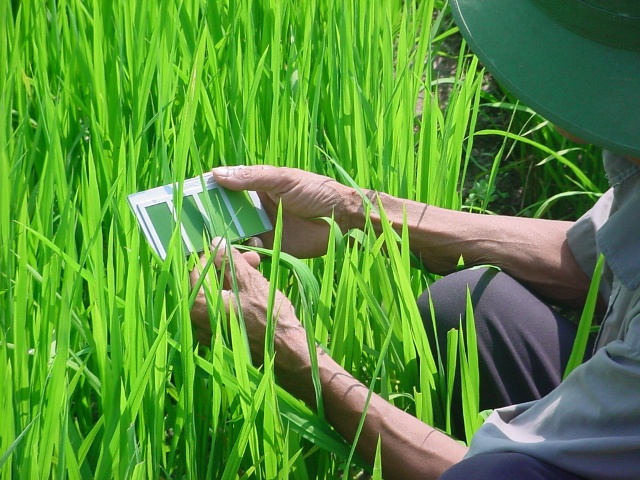Nutrient Expert (NE) tool-based site-specific nutrient management (SSNM) in rice and wheat crops can lower global warming potential by about 2.5% in rice and between 12% and 20% in wheat over farmers’ fertilization practice. More than 80% of the participating farmers increased their crop yield and farm income by applying the NE-based fertilizer recommendation. Adoption of NE-based fertilizer recommendation practice in all rice and wheat acreage in India would translate into 13.92 million tons more rice and wheat production with 1.44 metric tons (Mt) less N fertilizer use, and a reduction in GHG of 5.34 Mt CO2 per year over farmers’ current practice.

.
In recent years, the potential to mitigate climate change by improving nutrient use efficiency (NUE) in croplands has received considerable attention in agricultural research and policy agendas. The use of chemical fertilizers, nitrogen (N) in particular, in crop production is at the center of managing both food security and environmental problems. Enhancing crop yields through increased use of nutrients is essential to meet current as well as future food demand.
On the other hand, because fertilizer application in croplands is a major source of anthropogenic nitrous oxide (N2O) emissions, reducing greenhouse gas (GHG) emissions through proper fertilizer management is essential to address agriculture’s contribution to climate change. Moreover, excess and improper use of nutrients in crop production has large cost implications for the farmers. Therefore, improving NUE in croplands provides the opportunity to address the triple challenge of food security, farmers’ livelihood, and environmental protection, globally.
SSNM involves optimizing nutrient inputs considering demand (plant needs) and supply (from soils indigenous sources) of the nutrients according to their variation in time and space thereby ensuring field-specific nutrient management in a particular cropping season. Various technologies and practices such as Chlorophyll Meter, Leaf Color Chart, GreenSeeker, and decision support systems for instance Nutrient Expert and Rice Crop Manager are available for helping farmers to implement SSNM and improve NUE.
The NE tool was developed to implement crop nutrient management specific to farmers’ fields with or without a soil test. Although a few studies have evaluated the agronomic and environmental performance of NE, it has not been evaluated on a large number of farms with varying agro-climatic conditions and across various levels of crop intensification. Farmers’ participatory trials are useful to assess the utility of the tool and also enable farmers to make informed decisions for crop nutrient management.
This study presents results from a large number of on-farm participatory trials (1,594-paired data) comparing farmers’ fertilizer practices (FFP) vs NE-based nutrient management in terms of fertilizer inputs, yields, economic returns, and GHG emissions in rice and wheat fields in India. Rice and wheat are the major crops grown in India and consume 50% of the fertilizer used in the country.
The study in India was particularly important because India consumes 14% of total fertilizer use globally but its NUE is one of the lowest in the world. This is mainly driven by imbalanced and inadequate use of nutrients given the skewed government’s subsidy on nitrogenous fertilizer than on other nutrients.
The results of this study provide rich information to the agriculture and fertilizer policymakers to enable them to design fertilizer use and distribution policies and farmers’ support programs in the Indo-Gangetic Plains and other parts of the country.
Overall, NE-based recommendations reduced N input by 15%–35%, increased grain yield by 4%–8%, and reduced global warming potential by 2%–20%. The study also shows that NE-based SSNM is more important for closing the yield gap in low-intensive systems and decreasing nutrient input and minimizing nutrient loss in high-intensive systems.
Adoption of NE-based SSNM across all rice- and wheat-growing areas in India would translate into additional grain production of 13.92 Mt, N consumption reduction of 1.44 Mt, and total GHG savings of 5.24 Mt CO2 per year with some additional use of K fertilizer.
In smallholder production systems, where soil testing of each field is nearly impossible, a simple decision support tool such as NE could be helpful to promote SSNM, contributing to both food security and environmental sustainability goals.
Read the full study:
Sapkota TB, Jat ML, Rana DS, et al (2021) Crop nutrient management using Nutrient Expert improves yield, increases farmers’ income and reduces greenhouse gas emissions. Sci Rep 11: 1564






